Here are the essential concepts you must grasp in order to answer the question correctly.
Function Evaluation
Function evaluation involves substituting a specific input value into a function to determine its output. For example, if f(x) is a function, evaluating f(-1) means finding the value of the function when x equals -1. This is crucial for understanding how to compute values from the graph of the functions f(x) and g(x).
Recommended video:
Evaluating Composed Functions
Graph Interpretation
Graph interpretation is the ability to read and analyze graphical representations of functions. In this context, it involves identifying the values of f(-1) and g(-1) from the graph, which are necessary for calculating (f-g)(-1). Understanding how to extract information from the graph is essential for solving the problem.
Recommended video:
Graphs and Coordinates - Example
Function Subtraction
Function subtraction refers to the operation of subtracting the output of one function from another. In this case, (f-g)(x) means taking the value of f(x) and subtracting g(x) from it. To evaluate (f-g)(-1), one must first find f(-1) and g(-1) and then perform the subtraction, which is a fundamental operation in algebra.
Recommended video:
Adding & Subtracting Functions

 Verified step by step guidance
Verified step by step guidance Verified video answer for a similar problem:
Verified video answer for a similar problem:



 5:56m
5:56m